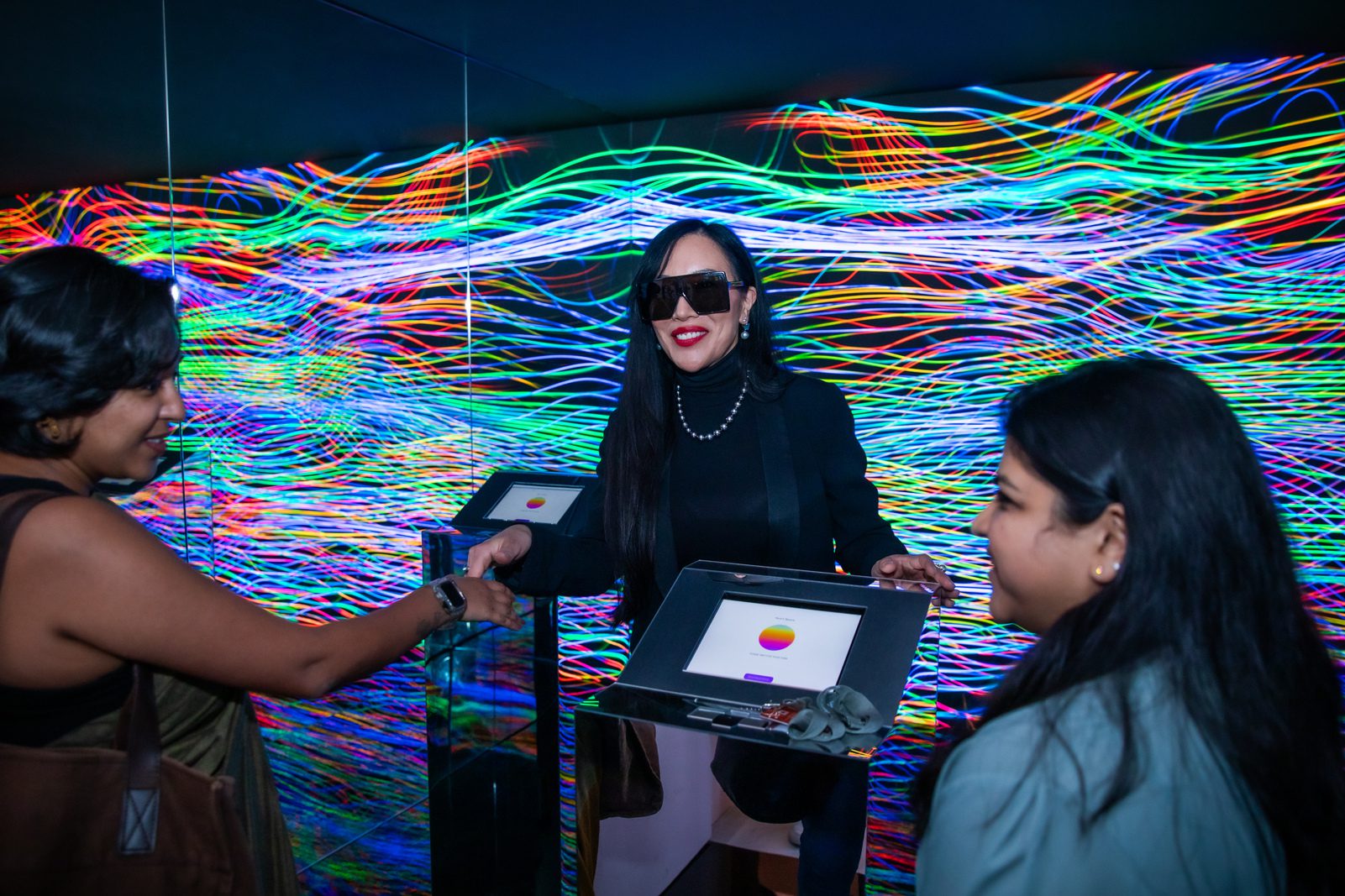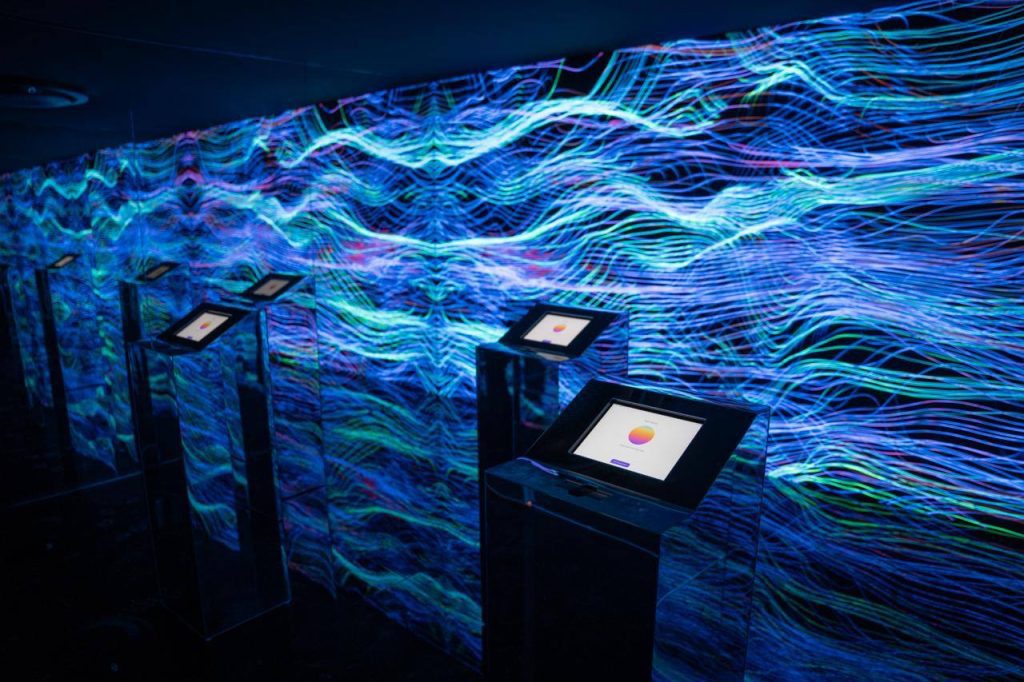In a world increasingly defined by the fusion of technology and humanity, digital artist Krista Kim stands as a revolutionary force. Her immersive installation ‘Heart Space’ at Art Dubai, commissioned by Julius Baer, epitomises the transformative power of digital art. Through ‘Heart Space’ and other visionary projects, Kim navigates the dynamic landscape of innovation and dialogue, reflecting on her artistic journey, the societal impact of her work, and the boundless possibilities for integrating art and technology in shaping our collective future.
hube: Given your exploration of digital consciousness, ‘Heart Space’ at Art Dubai appears to be a transformative experience. Could you delve into the emotional and psychological aspects you aimed to evoke in viewers through this installation?
Krista Kim: ‘Heart Space’ is an exploration of the concept of oneness. It merges technology with the organic to create a shared digital environment. It is a social sculpture where separate individuals come together to form a single, living artwork using Biometric AI generative technology. The installation’s mirrored walls and the rhythmic light patterns offer a hypnotic, meditative space where strangers can connect through the universal language of the heartbeat, synchronising in a moment of visual harmony.
The artwork goes beyond visual stimulation; it is a shared labour, a cooperative creative process that embodies the essence of togetherness. Each visitor leaves a transient, yet lasting imprint on the canvas, weaving into the social tapestry of ‘Heart Space’. Bathed in the symbiotic algorithms of light and colour, the artwork is a testament to human connection and the beauty found within our collective experiences.
h: In the context of the exhibition setting, could you describe any intentional design choices that enhance the viewer’s connection with the installation, creating a symbiotic relationship between the artwork and its environment?
KK: In curating the exhibition space for ‘Heart Space’, every design choice was intentionally made to deepen the viewer’s connection with the installation, fostering a symbiotic relationship between the artwork and its surrounding environment. The aim was to create an immersive experience that not only engaged the senses but also resonated with the viewers on a personal and emotional level.
The use of reflective surfaces and materials was a design choice aimed at blurring the boundaries between the viewer, the artwork, and the space itself. These elements served to reflect and amplify the light, colours, and movements within ‘Heart Space’, creating a sense of infinite space that encouraged viewers to contemplate their existence within the digital and physical realms.
Soundscapes played a crucial role in enriching the viewer’s experience, with compositions designed to evoke a sense of tranquillity and introspection. Healing sound frequencies music was composed by Ligovskoi, to complement the visual aesthetics, creating a harmonious sensory experience that encouraged viewers to lose themselves in the moment. The soundscapes were not static but evolved with the installation, ensuring that the auditory experience was as dynamic and engaging as the visual elements.
Lastly, the integration of interactive technologies allowed for a personalised experience, where the artwork responded to the presence and actions of each viewer. This interactive aspect of ‘Heart Space’ was essential in creating a symbiotic relationship between the artwork and its environment, making the viewer an active participant in the creation of the experience.
Through these intentional design choices, the exhibition setting of ‘Heart Space’ was transformed into a living entity that interacted with viewers in a deeply personal and meaningful way, illustrating the potential of digital art to create spaces that create human connection and an immersive experience of consciousness.
h: The concept of ‘Mars House’ as the first Metaverse home for sale as an NFT is groundbreaking. Beyond its financial success, how do you see this piece contributing to the evolving narrative of digital art as an essential aspect of our living spaces?
KK: ‘Mars House’ represents a pivotal moment in the evolution of digital art and its integration into our daily lives, establishing a new paradigm of the digital/physical connection, for what art can be and how it can be experienced. Beyond its financial success, the significance of ‘Mars House’ lies in its visionary approach to redefining the concept of digital/physical living spaces in the age of spatial computing/metaverse, AI and blockchain, marking a crucial step forward in the narrative of digital art as an indispensable element of our lifestyle.
‘Mars House’ challenges and expands our understanding of ownership, space, digital/physical identity and art in the digital era. It propels the notion that digital spaces can possess the same, if not more, value, emotional significance, and utility as physical ones. ‘Mars House’ is not just a virtual structure but a fully realised digital environment that offers a new way to experience art, architecture, and design, suggesting a future where our living spaces are no longer confined to the physical world but extend into the vast possibilities of the digital realm. Almost every asset that we own will have a digital twin or integration.
By integrating digital art seamlessly into the substrates of a Metaverse home, ‘Mars House’ showcases the potential for digital environments to be not only visually stunning but also emotionally and psychologically enriching. It emphasises the importance of art in creating healing, personalised spaces that reflect and cater to the individual’s aesthetic preferences and emotional needs, even in a virtual setting.
Moreover, ‘Mars House’ contributes to the evolving narrative of digital art by demonstrating its potential to foster new forms of social interaction and engagement within digital spaces. As the first Metaverse home sold as an NFT, it paves the way for artists, designers, and architects to explore the Metaverse as a canvas for innovation, creating spaces that are not only aesthetically unique but also deeply connected to the digital identity and community engagement of their inhabitants.
h: As a Cultural Leader for the World Economic Forum, your influence extends beyond the art world. In what ways do you believe the intersection of art and technology can shape societal perceptions and perhaps even influence policy discussions on a global scale?
KK: In my role as a Cultural Leader for the World Economic Forum, I recognise the unique potential of art and technology to educate and influence top decision-makers on critical, yet often overlooked, issues such as data privacy and digital identity. These topics, fundamental to our rights and freedoms in an increasingly digital world, require urgent and thoughtful deliberation at the highest levels of global governance and policy-making. Through the lens of art and technology, we can bring these invisible issues to the forefront, making them tangible and compelling to those who have the power to enact change.
Art, with its ability to evoke emotional responses and present complex ideas in accessible ways, is a powerful conduit for raising awareness and educating leaders about the nuances of data privacy and the importance of safeguarding digital identities. By integrating technology into artistic expressions, we can create immersive experiences that simulate the potential consequences of neglecting these issues, thereby making the abstract concepts of data privacy and digital rights more concrete and immediate.
At the World Economic Forum’s platform, I aim to bridge the gap between art, technology, and policy, facilitating dialogues that emphasise the ethical dimensions of digital advancements. The goal is to not only educate decision-makers on the critical nature of these issues but also to inspire a collaborative approach to developing solutions and policies that protect individuals’ rights in the digital realm.
The intersection of art and technology offers a unique and powerful avenue to influence societal perceptions and policy discussions on a global scale. By highlighting the importance of data privacy and digital identity as human rights issues, we can educate and motivate decision-makers to prioritise the immediate protection of individuals against the unchecked power of AI and other surveillance business models. This fosters a broader understanding of the ethical implications of our digital age, ensuring a more secure and equitable future for all.



